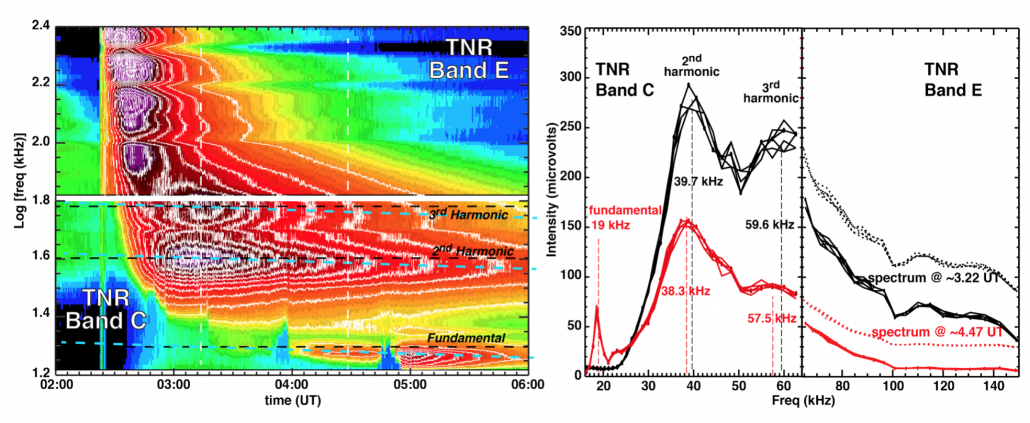Type III solar radio bursts, which appear as characteristic frequency-drifting features on radio dynamic spectra, are generated by energetic beams of electrons originating in solar active regions and propagating through the interplanetary medium. The remotely observed type III radiation consists of fundamental and harmonic components. Second harmonic electromagnetic radiation in type III solar radio bursts is well established at both high frequencies (metric and decametric wavelengths) and at low frequencies (kilometric wavelengths) (e.g. McLean & Labrum, 1985; Reiner, Stone, and Fainberg (1992)). Evidence for third harmonic radiation observed in type III bursts is very rare and often inconclusive or controversial. There have been reports of third harmonic components in the remotely observed radio emissions from type III bursts at metric and decametric wavelengths (e.g. Takakura, & Yousef, 1974; Brazhenko et al. 2012). Reiner, Stone, and Fainberg (1992) identified possible evidence for a third harmonic component in the local radiation at very low frequencies for one type III radio burst observed by the Ulysses spacecraft.
Observations
A recent article (Reiner & MacDowall, 2019) provides more direct and conclusive evidence for an electromagnetic third harmonic component in the type III radio emissions generated in the vicinity of the Wind spacecraft. These rare events, which were discovered using the high-time and high-frequency resolution radio data from the Thermal Noise Receiver (TNR) on the Wind spacecraft near 1 AU, have an advantage that the in-situ plasma density (and therefore plasma frequency) are precisely known, so enhancements at the second and third harmonic can be quite unambiguously identified in the frequency spectra.

Figure 1 – (Left) Dynamic spectral plot, with equal-intensity contours, of a type III radio burst on May 31, 2003 observed by the TNR instrument on the Wind spacecraft. Intensity peaks at the frequencies of the 2nd and 3rd harmonic of the local plasma frequency, as well as at the fundamental frequency, are clearly evident there and in the corresponding frequency spectra at 3.22 UT and 4.47 UT (Right). (More details in Reiner & MacDowall, 2019 )
Evidence for a third harmonic in the local radio emissions is exceedingly rare and difficult to positively identify, due in large part to the masking by the more intense remote radio emissions from the type III burst. From detailed analyses of hundreds of the low-frequency type III bursts over the 24 years of the Wind observations only about a dozen events were identified as indicating a possible 3rd harmonic component. The article presents detailed analyses of five of these events that are believed to provide unambiguous and compelling evidence for a third harmonic component in the local type III radiation observed at or near the type III source region at 1 AU.
One example of a type III burst observed by the Wind TNR radio instrument from May 31, 2003 is shown in Figure 1. This color-coded contour plot of the low frequency portion of the type III radio burst, in the frequency range from 16 kHz to 250 kHz and from 02:00 to 06:00 UT, shows peaks at frequencies of the 2nd and 3rd harmonic of the local plasma frequency. These enhancements near 40 and 60 kHz, which are in the frequency ratio of 3/2, are more evident in the frequency spectra at 3.22 UT and 4.47 UT on the right, which correspond to vertical slices through the dynamic spectrum on the left. After 04:00 UT a new contour peak, corresponding to the fundamental electromagnetic component, is observed near 20 kHz. The calibrated data from the superheterodyne receiver on Wind enabled us to estimate that the 3rd harmonic component was about 1/3 as intense as the 2nd harmonic.
Conclusions
These observational results suggest that type III radio emissions generally consist of fundamental, 2nd harmonic, and at least sometimes 3rd harmonic components. While enhancements at the 2nd harmonic in the local type III radiation are very commonly observed, clear enhancements at the 3rd harmonic appear to be very rare. Nevertheless, these results confirm the “clue” of a third harmonic previously observed for the Ulysses event from 1990, and provide further credence to the rare reports of third harmonic components in the high-frequency remotely observed type III radiation by ground-based observatories. We found the 3rd harmonic components to always be less intense than the 2nd harmonic, with 3rd to 2nd harmonic intensity ratios ranging from 0.3 to 0.7. We also found that sometimes a 3rd harmonic component was expected but was not observed. These new results are of considerable importance for the development and assessment of theories and models of type III radio generation in the interplanetary medium.
Based on the recent paper by M. J. Reiner and R. J. MacDowall “New Evidence for Third Harmonic Electromagnetic Radiation in Interplanetary Type III Solar Radio Bursts”, Solar Phys (2019) 294: 91. DOI: 10.1007/s11207-019-1476-9
References
Brazhenko, A.I., Melnik, V.N., Konovalenko, A.A., Pylaev, O.S., Frantsuzenko, A.V., Dorovskyy, V.V., Vashchishin, R.V., Rucker, H.O.: 2012, Odessa Astron. Pub. 25, 181.
McLean, D. J. & Labrum, N. R. “Solar radiophysics : studies of emission from the sun at metre wavelengths”, Cambridge University Press, 1985.
Reiner, M. J.; Stone, R. G.: Fainberg, J.,: 1992, Astrophysical Journal,.394, 340
Takakura, T., Yousef, S.: 1974, Solar Phys. 36, 451
*Full list of authors: Michael Reiner and Robert MacDowall
